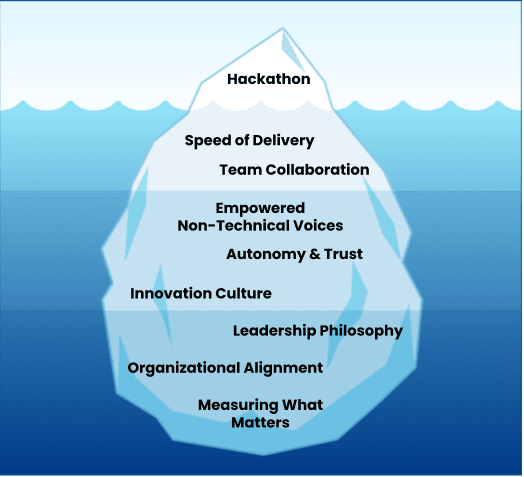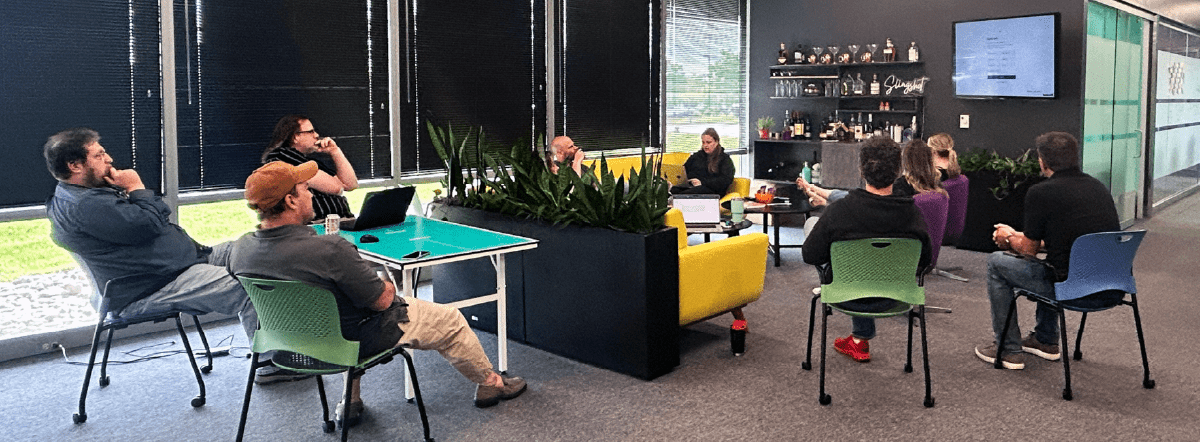For years, hackathons have been the wild west of innovation. Teams raced against the clock in caffeine-fueled sprints, huddled over laptops, rushing to cobble together a minimum viable something.
But something’s changed. Today’s hackathons, especially those within AI-forward organizations, are more than just faster; they are also more effective. They’re more inclusive, more collaborative, and more productive.
What we’re seeing isn’t an upgrade, it’s a reinvention. AI is rewriting the playbook for how teams collaborate, create, and deliver value in real time.
Summary
AI hasn’t just made hackathons faster; it’s transformed who participates, how teams collaborate, and what gets built. Cross-functional teams now prototype in hours, roles are blending, and innovation happens well beyond the event itself. This is what the future of problem-solving looks like.
From Code Race to Collaborative Experiments
If you’ve ever been part of an old-school hackathon, you know there was lots of upfront discussion followed by everyone crowding around one person typing as fast as they can. The goal was to ship anything before the timer hits zero.
“Even those teams… You had one machine, and you’re all kind of huddled around that one machine working together,” said Steve Anderson, Principal Developer at Slingshot.
The dynamic has shifted dramatically. In Slingshot’s recent AI-powered hackathon, collaboration wasn’t just a buzzword; it was the backbone. Designers, developers, and product owners were co-creating in real time using shared tools. Everyone was building, tweaking, and validating side by side.
“Because of the tools… the Product Lead who’s not typically a designer, but she was able to collaborate with me in the tool,” said Rachel Foster, Principal UX/UI Designer at Slingshot. “It was both of us tackling the design issues and spinning up things twice as fast”.
The days of one keyboard and four spectators are behind us; cross-functional collaboration is no longer optional.
Speed Isn’t Just Faster. It’s Smarter.
Hackathons have always been about speed. However, traditional ones often sacrificed quality for expedited delivery. You’d get something demo-worthy, but rarely usable.
“The UI used to be the first thing to go,” laughed Chris Howard, Slingshot’s CIO. “You’d get a text box with zero colors and a single button.” Not anymore.
Today’s AI-enabled hackathons move faster and better. Teams aren’t just building to make sure it’s possible; they’re creating polished, interactive prototypes with real user interfaces and cleaner codebases. With tools like Claude and Cursor accelerating dev time, and platforms like Lovable and Aura aiding design, teams can move from concept to prototype in days, not weeks.
“The amount of code you can turn out is just massively, substantially more,” said Steve. “You get a huge head start and can start making things more polished. Things that you would normally throw by the wayside to get to the core of the problem, you can do them now.”

AI Tools Flatten the Learning Curve and Blur the Lines Between Roles
Traditionally, hackathons had clearly defined roles: designers design, developers code, and product teams write user flows. But AI is changing that.
Tools like Lovable, Bolt, and Aura allow non-developers to prototype ideas. Product Leads can visualize faster. Designers can generate working HTML and CSS. Developers can refine rough outputs into production-ready features.
Even better, these tools allow ideas to evolve outside the hackathon itself. Rachel noted that “someone could spark an idea on a weekend, build a prototype with AI tools, and bring it to the Monday morning team meeting. The cycle of innovation becomes continuous”.
This fluidity isn’t just a nice-to-have. It’s redefining what roles look like. “If you are a developer who understands the business need, you can get to a solution much faster,” said Chris. “You have more ability, because when you hit an error or limitation within those tools, you can export the code and take it the last mile.”
The Tools Are Evolving. So Are the Workflows.
The current tool landscape isn’t perfect, but it’s powerful. Different AI design and development platforms each come with their strengths and blind spots.
Aura, for example, impressed the team with its design polish and animation capabilities. It can export to Figma and supports bidirectional workflows, which was a game-changer for design iteration.
“It’s sleeker on the UI side and provides animation support,” said Rachel. “You can export to Figma, fix some things, and re-import it; all without re-prompting”.
Still, there are some limitations. “None of these tools play well with both design and development,” said Chris. “You either hit a dead end on the dev side or the design side. It’s frustrating for now, but it’s improving fast”.
Despite the occasional workflow friction, the net effect is overwhelmingly positive. These tools don’t just build faster. They enable smarter handoffs, quicker feedback loops, and the continuous integration of ideas across the stack.
AI Breaks Silos and Elevates Collective Intelligence
One of the most profound changes brought on by AI-enabled hackathons is cultural. They dismantle silos and elevate the whole team.
At Slingshot, the traditional handoff model (discovery to design to development) is giving way to a more fluid, co-creative model. Product, design, and development are in the room from the start, each contributing across disciplines.
“I think what was highlighted in that hackathon was collective intelligence,” said Chris. “When you bring together a group of smart people with complementary skills like product, design, and dev, then add in AI, it accelerates the timeline and results in new ideas. You don’t just get there faster. You get there better”.
In this model, the tools become enablers of creativity, not barriers. Anyone can move an idea forward; everyone can prototype. As Rachel put it: “It’s hard to be collaboratively creative when there are massive silos. This breaks those down. It creates a more fluid experience and allows a lot of brains to come together”.
What This Means for CIOs
So why does this matter? Because hackathons are just the tip of the iceberg.
They reveal how your teams work (or don’t.) And they’re a microcosm of how technology can accelerate outcomes when paired with the right culture and tools.

CIOs navigating AI transformation should be asking:
- Are we enabling creative, cross-functional exploration?
- Do we have tools that empower non-technical contributors?
- Are we measuring speed alone or the quality of innovation?
The new hackathon model demonstrates that when you align the right people, provide them with access to AI-native tools, and trust them to move quickly, magic happens. You don’t just ship faster; you ship smarter.
Final Thought: Hackathons Are Just the Beginning
AI hasn’t just made hackathons faster. It’s made them collaborative, continuous, and creative in ways we never imagined.
And if that’s what happens in a one-day sprint? Imagine what your team could do in a month.
Want to see AI + Product in Action?

Written by: Savannah Cherry
Savannah is our one-woman marketing department. She posts, writes, and creates all things Slingshot. While she may not be making software for you, she does have a minor in Computer Information Systems. We’d call her the opposite of a procrastinator: she can’t rest until all her work is done. She loves playing her switch and meal-prepping.

Expert: Chris Howard
Chris has been in the technology space for over 20 years, including being Slingshot’s CIO since 2017. He specializes in lean UX design, technology leadership, and new tech with a focus on AI. He’s currently involved in several AI-focused projects within Slingshot.

Expert: Rachel Foster
As UX Lead, Rachel helps guide the design team through strategy, interviews, creation, and testing. Designing software and apps to be both intuitive & beautifully impactful plays into Rachel’s strong desire to connect others. Relying on her Fine Arts background & honed intuition, she gets sudden flashes of ideas and follows them wherever they lead.

Expert: Steve Anderson
Steve is one of our AWS certified solutions architects. Whether it’s coding, testing, deployment, support, infrastructure, or server set-up, he’s always thinking about the cloud as he builds. Steve is extremely adaptable, and can pick up the project and run with it. He’s flexible and able to fill in where needed. In his spare time, he enjoys family time, the outdoors and reading.




